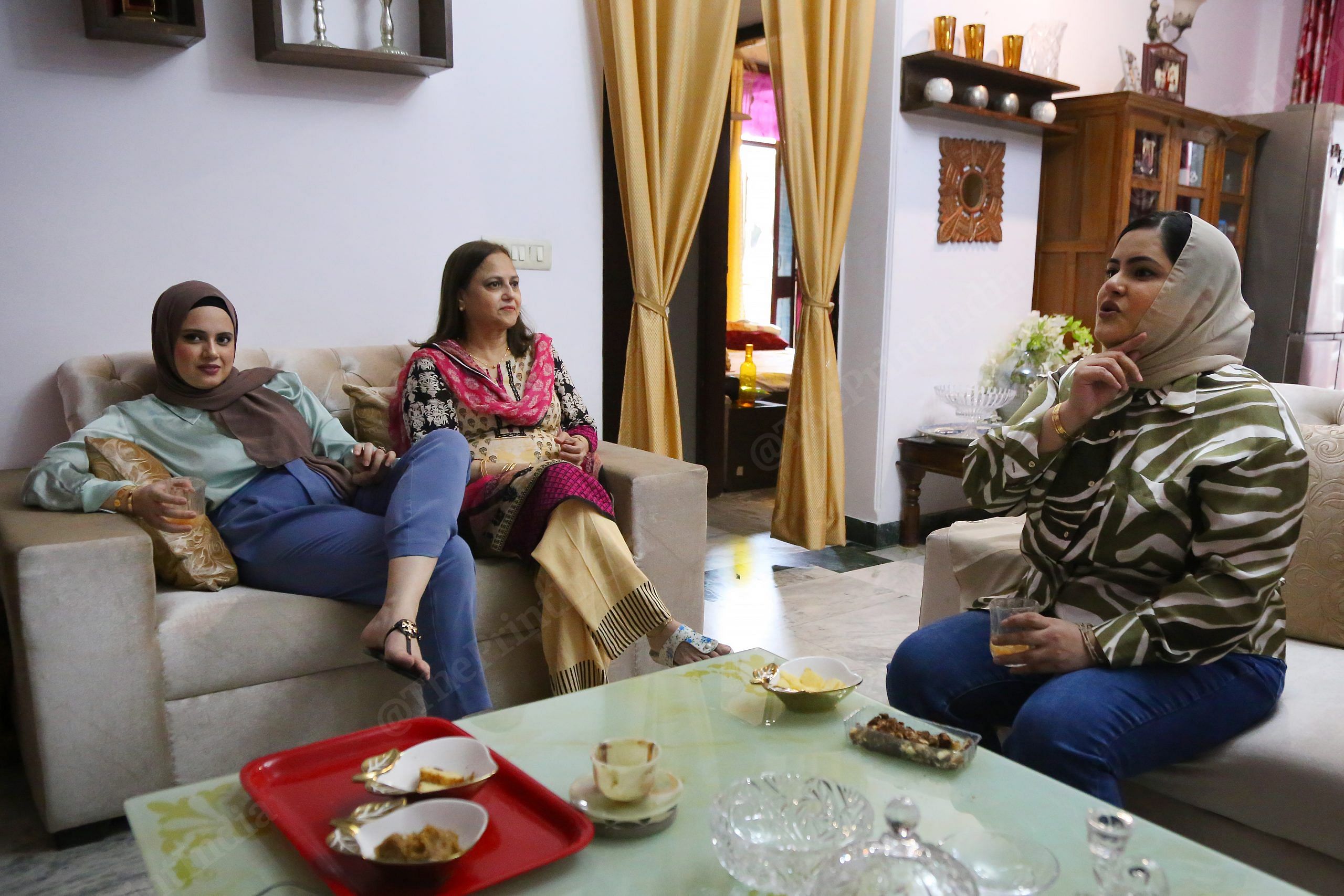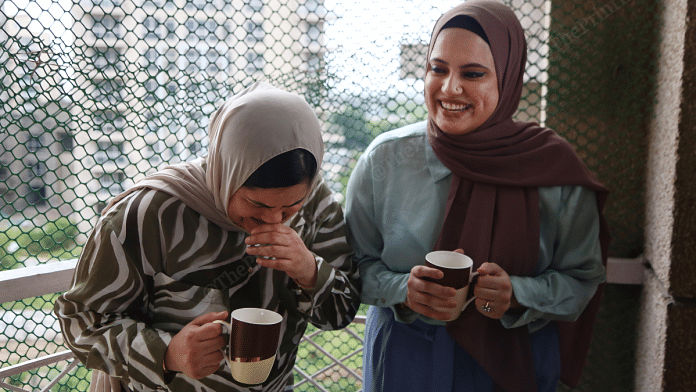New Delhi: How do you become a Muslim Instagram influencer in India and not look weak and victimised? Uttar Pradesh’s ‘Bajis’ — Shazma and Soha — are doing it. They flex their identities on reels and attack the lazy stereotypes that go with being a Muslim — Urdu dialects, ghazals, biryani, Eid sewaiyaan, sherwanis, and kohl-lined eyes. It’s a cultural commentary through which the Bajis are shifting the gaze.
For the two sisters, Shazma, 31, and Soha, 28, satire, irony, and slapstick humour are their tools and society their muse.
“We want to break the stereotype about Muslim women, both inside our community and outside,” says Shazma. “Muslim families should watch our content.”
One of the more popular reels has TV actor Shirin Sewani attempting to speak Urdu like they do in the movies. Sewani is shown to be visiting a Muslim family and gets visibly excited when a woman wearing a hijab opens the door and says, “Yes, I remember!… Assalmualaikum aunty jaan,” to which Shazma simply says ‘hi’. Sewani speaks in over-the-top Urdu with the bemused family, and when it’s time to leave, she becomes the stuff of Bollywood Muslim social — “Khuda hafiz aunty ji, salaamwalekum, shabba khair aunty jaan, Allah aapka maqbara banwaye (may Allah build your tomb), aapki sultanat zindabad, zill-e-Ilahi zindabad, Khuda hafiz aunty jaan…”
The Bajis have become so successful on Instagram that they have quit their jobs to handle their account. Shazma was a software engineer and Soha a journalist. Their social media handle is now the 24×7 challenge—they need to keep upping their game for millions of followers and endorsements.
They are Muslim influencers, but their subject is as much about Muslims as non-Muslims. At times, it becomes difficult to figure out who they are mocking. The expectations heaped on young Muslim women aren’t lost on the Bajis. At times, humour also turns inward. One reel shows a mother and daughter arguing about wearing lipstick. The mother forces her unmarried daughter to remove it, but after getting her married, she insists that she paint her lips a dark red — the more the better.In another reel, Sewani asks Shazma what she’s brought to eat. “Tinde ki sabzi,” is a succinct reply. But what Shazma hears back isn’t surprising: “You guys eat that, don’t you… kebab, tikka, biryani?”
‘Hindus and Muslims, both target us’
In a society seething with outrage, humour has become a double-edged sword. The sisters get their fair share of brickbats and barbs from Hindus, Muslims and even people from Rampur, where they were brought up and whose style of talking they imitate. The Rampuri dialect, also known as Khariboli, is a Western Hindi variety spoken mainly in northwestern UP. Interestingly, the dialect resonates with people in Old Delhi too — inside the gullies and crannies of Chandni Chowk, Jama Masjid, and Chawri Bazaar, there’s a thriving Muslim culture that indulges in the sways of the dialect and therefore, identifies with the Bajis, sharing reels on their Instagram accounts.
But their success is their vulnerability too — consider their religion and gender, and it becomes a perfect ground for online threats and harassment. “People from both communities, Hindu and Muslim, target us. Muslims say that we are going against Islam,” says Shazma. In this line of work, there’s no pleasing anyone. Hindu commentators mock and ridicule their hijab or burqa. The Muslims get angry if their dresses are too revealing. A user commented, “You shouldn’t wear Western dresses with a hijab.”
In their early videos, the Bajis did not cover their heads. When they started gathering more and more attention on Instagram, they started wearing the hijab. “Not from the pressure but by choice,” the Bajis insist. It’s the quintessential ‘Muslim element’ — bringing their identity into sharper focus.
A photo in which Shazma is seen in a dress revealing her knees became an instant target of intra-community hatred. A Muslim woman messaged her saying that she should not wear those kinds of clothes because she is a Muslim. “Muslims do different types of public shaming. They say we are working against Islam and that we are shameless,” says Shazma. Another even condemned them to eternal damnation. “You both sisters will be the first to enter Jahannum (Hell) just because you are making videos,” they said.
“We are not here to spreading Islam. We are not preaching to anyone. Don’t judge our personal lives with my social media posts,” says Shazma, her voice tinged with anger.
Inspired by Raj Kundra, last year, the Bajis made a video on Karva Chauth. The video sported a woman seeing food instead of her husband through the sieve. It opened the floodgates of hate. “If Raj Kundra does the same thing, then no one has any problem. But if we say it, we are called anti-national. Is it just because we are Muslim?” asks Shazma. The viciousness is scary. On Eid-ul-Adha, the Bajis played a joke on sacrifice. Among the animal emojis they used in the caption, one represented a cow. Under a barrage of hate and threats, they deleted it.
Some people have accused the Bajis of mocking Rampur with their imitation of the dialect. Criticism is based on the grounds that it is spoken by largely ‘backward’ Muslims and is an ‘embarrassment’ for upwardly mobile Muslims in metropolitan areas who are trying to break out of that culture. While it’s something that elite Muslims are ‘ashamed’ of, they secretly indulge in it too. “They called us jaahils (illiterate). Are we ashamed of it? No, this is our accent, and we should be proud of it,” says Shazma.
Their gender is also wielded against them, and prejudice is rampant in their extended family as well. According to Soha, some of their relatives tell them that “women from good homes do not do all this”.
Initially, the sisters would try and explain the rationale behind their clips. “We used to get very upset, but now we have learnt how to handle these people. Now, trollers are the characters of our videos. They give us content to produce more clips,” Soha adds. Even their most vicious critics are an opportunity.
Shazma and Soha remain resilient under the barrage of hate, thanks to the support from their immediate family. “My daughters are telling the truth of society,” says Seema Khan, the Bajis’ mother, who blames the film industry for reinforcing stereotypes.

But there are times when the Bajis have to walk on eggshells.
According to their close friend Kartiki, the sisters do censor themselves. They’ve seen too many influencers brought down by angry online mobs. Now, they try to be extra careful with content so that they don’t land up in any controversy. They also steer clear of ‘heated topics’.
“We have seen many content creators who have stopped expressing themselves freely. Seeing them also makes us feel insecure,” says Soha. She yearns for the freedom to create content without fear.
Also read: ‘Not a common tailoring job’—Muslim women in Malerkotla stitch flags for Har Ghar Tiranga
Going viral during lockdown
Shazma and Soha shot to fame almost by accident.
In 2020, during the lockdown, Seema Khan came across Kusha Kapila and Dolly Singh’s Behensplaining on YouTube. She noticed that their content delivery was similar to the Rampuri-style dramas her daughters performed at home. On a whim, she asked her daughters to make a video during the lockdown. And the Bajis produced a small skit on Musim women talking among themselves in typical Rampuri style —Soha complained about her various ailments while Shazma bemoaned the responsibility of marrying off her six daughters. Seema shared it on WhatsApp, and within days, it went viral.
“People demanded more such videos, but only because of the lockdown,” Seema says. Buoyed by their success, Shazma and Soha started putting up more videos on Facebook as ‘The Bajis’. In their first month, they got 50,000 views, but in less than three months, the number spiked to over 1,10,000. Although it’s been less than three years since Shazma and Soha started experimenting on social media—first on Facebook and then on Instagram—they have a dedicated following of over 2,30,000 fans. Their reels often get millions of views. The sisters deliberately eschewed tried-and-tested paths to influencer fame. They wanted to hold a mirror to society with ‘clean’ and ‘relatable’ content.
Also read: Cellulite to sex—Gen Z influencers Aaliyah Kashyap, Sayanti mint money by ‘keeping it real’
Muslims are taking it to social media
Over the last few years, more and more Muslims have been becoming active participants on social media. Many feel compelled to dispel stereotypes about their communities and address hatred. A study by the Centre for the Study of Developing Societies (CSDS) found that the socially and educationally backward Muslim community in India is second only to the upper castes in terms of social media usage.
Women wearing hijabs on social media are regularly churning out content — from providing make-up and fashion tips to performing stunts. Saloni Gaur, a student at the University of Delhi, created the hugely popular character called Hijabi Najma Appi who talks on topics ranging from Delhi’s pollution levels to the Citizenship (Amendment) Act.
What the Bajis choose to wear is a deliberate decision. “Dressing modestly and still being able to create content is what has helped us to stand out in the crowd. Even at events, co-creators really appreciate the way we dress up and manage to be a part of the content creation world with our hijabs,” says Soha.
Also read: Tulsi to strawberry—How desi gin from Goa is converting India’s vodka loyalists
PR, Bollywood, Amazon and content creation
Soha and Shazma look at content creation as a profession. Quitting their jobs to focus on their social media profiles was a calculated business decision. They say that they earn more money now.
The Bajis have partnered with brands such as Amazon, Unacademy and Mamaearth. Bollywood, too, regularly knocks on their doors. They’ve been roped in for PR jobs for films like Laal Singh Chaddha (2022) and Shamshera (2022).
According to Instagram marketing expert Pratyusha Mulchandani, brands that find it worth their while to tie up with the Bajis are mainly OTT platforms, skincare and makeup brands, and production houses looking to promote their films. “As entertainment creators, they have a huge female following, which gives them the best of both worlds,” she says.
The sisters are aware of the fickle nature of fame, but say that the plethora of social media platforms democratises the content creation industry. It’s “not always rainbows and sunshine”, but the sisters are ready to move to another platform or medium should they feel restricted on Instagram.
While this is a measure of their success, they’ve often been asked to become more glamorous and fashion-forward. “Because of this, many times, brands don’t give us work. Some companies have said that our content is not ‘Gen Z’,” says Soha.
(Edited by Humra Laeeq)






